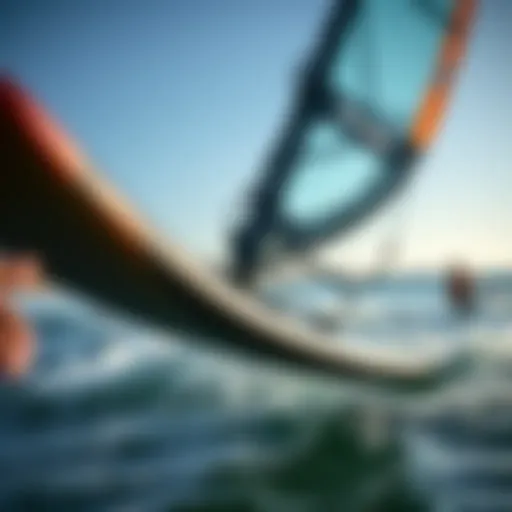Top Surfing Destinations on Hawaii's Big Island
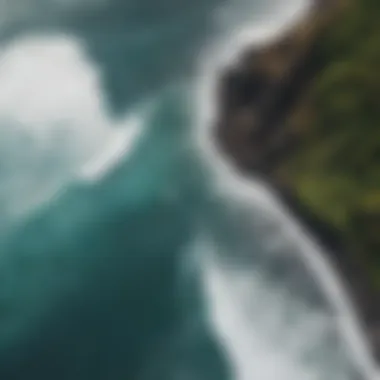

Intro
When it comes to riding the waves, Hawaii's Big Island holds a special place in the hearts of surfers. The island is not just about the spectacular scenery or the laid-back island vibes; it's a veritable playground for wave riders of all skills. Each surf spot here tells its own tale of oceanic power and local culture, enticing both amateurs and experts alike to paddle out and test their mettle against the mighty surf.
In this guide, we will delve into the island's most renowned surfing locales, explore the nuances of surf conditions, and understand the cultural significance tied to these coveted spots. As you venture through the article, you'll gain insights into the vital aspects of surfing here, from the essential gear needed to hit the waves to the seasonal patterns that dictate surf quality.
As the sun glistens on the pristine waters, prospective surfers will also find a wealth of information regarding local regulations, surf schools for honing skills, and the ecological concerns that accompany such an exhilarating sport. The aim is simple; to enrich your surfing experience on this remarkable island while ensuring that nature is respected and preserved. Without further ado, let’s immerse ourselves into the fascinating world of surf gear and equipment.
Preamble to Surfing in Hawaii
Surfing stands as more than just a recreational pursuit in Hawaii; it embodies a way of life intertwined with the islands’ rich cultural tapestry. This article aims to provide an in-depth glimpse into the significance of surfing across Hawaii with a keen focus on the Big Island, where the waves offer something for every skill level.
Historical Context of Surfing
Surfing's history in Hawaii stretches back centuries, rooted in traditions that predate Western influence. Polynesian voyagers brought the sport with them when they settled on these shores, treating it as a rite of passage and an expression of prowess. Early accounts feature royalty riding waves as a demonstration of status and skill, utilizing wooden boards crafted from local trees like the koa. This foundational aspect emphasizes a connection to the ocean that is deeply ingrained in Hawaiian culture.
The historical narratives reveal surfing as an art form, with various schools of thought regarding technique and board type that evolved collectively over generations. Modern surfing, while distinct from its ancestral roots, still reflects the values and practices established by those early wave riders. This historical context is crucial, as it brings to light the deeper significance surfing holds for the Hawaiian people and its enduring legacy.
Importance of Big Island in Surf Culture
The Big Island, due to its diverse geography, presents unique surf conditions that are both inviting and challenging. From the rugged cliffs of the Kona coast to the tranquil shores of Hilo, this island contributes immensely to Hawaii's surfing narrative. It is on these waves that both amateurs and pros can carve their path, often within the same stretch of water. This fusion of skill levels enriches the surfing community, fostering a spirit of camaraderie that is hard to find elsewhere.
Moreover, the Big Island serves as an ambassador of Hawaiian surf culture, showcasing the local traditions, attire, and lifestyle associated with the sport. Surfing here is not merely about catching a wave; it’s about engaging with a culture that balances respect for the ocean, towards fellow surfers, and the history that came before.
"Surfing is not just a sport; it’s a way of connecting with the waves, the culture, and the land we ride on.”
Thus, understanding the importance of the Big Island in the broader surf culture context encapsulates not only the physical thrills of surfing but also the ethos behind it. Whether one rides waves or simply admires them from the beach, the island’s surfing heritage is palpable and essential to grasp for anyone wishing to dive into this world.
Overview of the Big Island
In the realm of surfing, the Big Island stands as a revered destination teeming with unique geographical characteristics and cultural significance. For surfers, this island offers a tapestry of experiences that stretch beyond just catching waves; it embodies the spirit of the ocean and the respect that comes with riding its currents. Understanding the fundamentals of the Big Island enhances every surfer's journey, from beginners to seasoned veterans. Each surf spot is not merely a location but a blend of the island’s rich cultural heritage and diverse landscapes.
Geographical Features
Hawaii's Big Island, known as Hawai'i Island, is a geographical wonder that plays a significant role in shaping its surf culture. It is the largest of the Hawaiian Islands, boasting a range of environments, each influencing surf conditions and culture. From the rugged cliffs of the Kohala Coast to the black sand beaches of Puna, the diversity here is remarkable.
The island consists of multiple volcanic mountains, with Mauna Kea towering as the tallest. Each coastline offers distinct surf breaks; for instance, the Kona Coast is noted for its reliable waves and clear water, while Hilo's shores can deliver powerful swells. Moreover, local features like reefs and rocky outcrops create unique wave dynamics. Surfers often find treasure troves of picturesque views and formidable challenges at these breaks, making the Big Island not just a place to surf, but a place to connect with nature’s raw beauty.
Climate and Weather Patterns
When considering surfing on the Big Island, weather plays an instrumental role. The climate is generally warm and inviting, with temperatures averaging between 70°F and 85°F, bolstering year-round surfing activities. However, it is not just sunshine that defines the surfing experience. Wind and precipitation patterns have a massive impact on wave height and quality, vital for surfers scouting their next ride.
The island experiences two distinct seasons: a dry season from May to October and a wet season from November to April. During the wet season, surfers might encounter more significant swells, particularly on the eastern side, as storm systems build farther out at sea. On the other hand, the summer months yield more stable and beginner-friendly conditions along the south and west coasts, making it a great choose for those just starting their surfing journey.
"Big Island is not just about surfing; it's about experiencing a rich tapestry of culture, nature, and the thrill of the ocean."
Hybrids of these geographical features and climate specifics create varied surf environments that beckon surfers from around the globe. Embracing the conditions of the Big Island fosters not only skill improvement but also a deeper appreciation for this enchanting surfing haven. The experience here transcends the waves, merging adventure with education and respect for the local community and ecosystem.
Top Surf Spots on the Big Island
Surfing on Hawaii's Big Island is not merely a sport; it's a cultural cornerstone. It offers something for every wave-rider—whether you’re a seasoned pro or a first-time paddler. By exploring the top surf spots on the island, surfers can tap into the local surf culture, find spots that match their skills, and appreciate the natural beauty surrounding them. Identifying the right surf spots also empowers surfers to make informed decisions, enhancing their experience and keeping safety in mind.
Kona Coast
The Kona Coast is a surfing paradise. It's well known for its sunny weather, warm waters, and, most importantly, its stunning beaches that cater to a variety of surf styles and skill levels. The beaches here are often buzzing with activity and offer numerous options for surfers to explore.
Best Beaches in Kona for Surfing
Kona boasts picturesque beaches such as Kahalu'u Beach and Pine Trees, which are excellent for surfing. Kahalu'u is famed for its gentle waves, making it a perfect playground for beginners. It is often busy with surf schools and families, adding to its friendly vibe. The vibrant marine life adds a unique charm that sets this beach apart.
On the other hand, Pine Trees caters more to intermediate and advanced surfers. The waves can get quite strong, especially during the winter months, offering thrilling rides but also demanding respect and caution.
In summary, the versatility of the beaches in Kona makes it a sought-after spot for diverse surfing experiences, from easy-going swells to more challenging breaks.
Local Surf Breaks
Local surf breaks, like Lyman’s and Kona’s Bay, enhance the surfing scene here. Lyman’s is well-loved among locals for its reliable waves and less crowded conditions. Surfers who find hidden gems like this often leave with stories and a sense of connection to the community.
However, it’s critical for visitors to be aware of the local etiquette when accessing these breaks. Respecting the locals and understanding the rules of the water are essential. The key here is not only to enjoy the waves but to do so in harmony with the surfing culture that flourishes in these waters.
Hilo’s Swell
Hilo may not be as popular as Kona, but it holds a special charm. This area is unique, characterized by powerful surf with consistent waves that attract those looking for more exhilarating experiences. Hilo offers an entirely different aesthetic compared to Kona: lush, green surroundings meet the ocean, giving surfers a refreshing environment as they ride the waves.
Breakdown of Hilo's Waves
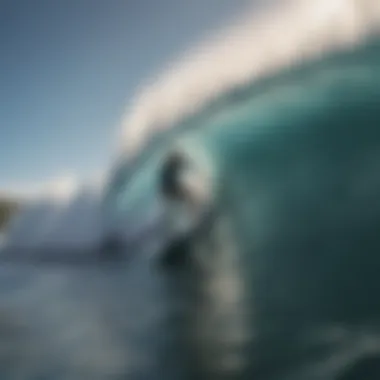

Hilo's waves can vary significantly. Known for its powerful swells, it attracts experienced surfers. Some breaks here, like Honolii, provide robust waves that can challenge even seasoned pros. The surf here is influenced by trade winds and seasonal patterns, which creates a dynamic surfing environment.
Visitors should be prepared for the unpredictable changes in wave size and strength, making it both thrilling and daunting. Thus, Hilo stands out as a destination where surfers can truly push their limits while enjoying the beautiful backdrop.
Seasonal Variations in Surf
The surfing conditions in Hilo fluctuate with the seasons. The winter months generally see larger swells, appealing to thrill-seeking surfers eager for a challenge. In the summertime, conditions are milder, allowing beginners to gradually improve their skills.
This variety allows surfers to choose the best time for their skill levels, ensuring a safe yet enjoyable experience. The ideal strategy is to familiarize oneself with the seasonal patterns in order to maximize one’s time in the water.
Puna Region Hot Spots
The Puna region is home to surf spots that are often overlooked. This area provides a distinctive surfing atmosphere, often recognized for its wild beauty and uncrowded beaches.
Hidden Gems for Advanced Surfers
Puna offers hidden gems like Pohoiki Black Sand Beach and Schofield's. These spots generally see fewer crowds, allowing more freedom to ride the waves. The waves here are challenging, often preferred by advanced surfers searching for thrills. The rugged coastlines and notable scenery make riding here distinctly rewarding.
However, these hidden gems should be approached with caution; local knowledge can be invaluable when navigating these surf conditions. The unique feature of Puna's surf spots is the chance to find solitude while riding fantastic waves, a rare combo that seasoned surfers often seek.
Surf Conditions and Local Tips
Each surf spot has its own rhythm; understanding wind patterns and tide influences here is crucial. Local surfers are great resources, and observing traditional surf etiquette helps nurture a positive environment. By chatting with locals, one can discover alternative spots or timely tips that greatly enhance the surf experience.
Surf Conditions and Best Times to Ride
Understanding the surf conditions and finding the best times to ride is crucial for surfers aiming to make the most out of their experience on the Big Island. The ocean isn’t just a flat sheet of water; it’s a dynamic, ever-changing entity shaped by various natural forces. Knowing when the conditions align favorably can mean the difference between a thrilling ride and a frustrating day.
What surfers need to remember is that conditions aren’t just about wave height. Factors like wind direction, tide cycles, and swell patterns play pivotal roles in how the water behaves. Each of these elements can enhance or hinder the surf experience.
With this knowledge, surfers gain the ability to plan their trips effectively, ensuring they glide through the best waves and dodge those times when conditions might be less forgiving.
Understanding Waves and Tides
Swell Patterns
Swell patterns refer to the movement and formation of waves as they travel across the ocean. Surfers on the Big Island need to pay keen attention to how these swells are generated and how they arrive at the shore. The unique feature of swell patterns lies in their origin, informed by distant storms and weather conditions.
Swell patterns can be classified into short-period and long-period swells. Short-period swells typically bring faster, choppy waves ideal for advanced surfing, while long-period swells offer smoother, more consistent rides, often favored by beginners and those looking to enjoy a steady surf.
One of the main advantages of understanding these patterns is the ability to predict when swells will peak, aligning perfectly with your available surfing time. However, they can also have their drawbacks, including the potential for inconsistent wave conditions which can leave surfers feeling like they’re rolling the dice.
Tide Influences
Tide influences are equally important in shaping the surf conditions on the Big Island. Tides are caused by the gravitational pull of the moon and the sun, causing daily variations in sea level. This process creates different surf environments. For instance, some surf breaks work best during a high tide while others are more favorable at low tide.
A key characteristic of tide changes is their timing; they follow a predictable cycle, usually spanning about 12 hours. Knowing the tide schedule can help surfers time their sessions, ensuring they’re riding during optimal conditions. A unique feature of tide influences is the ability to transform a surf spot entirely. A break that’s unplayable at high tide may become a paradise for surfers as the tide pulls out.
However, not all tides offer equally advantageous conditions. Local knowledge becomes invaluable—it’s essential to speak to other surfers about which spots are best under specific tide situations.
Optimal Surf Seasons
Seasonal Trends
When it comes to surfing on the Big Island, seasonal trends are significant. These trends provide insights into when to expect the best waves based on historical patterns. The Big Island experiences two primary seasons: a winter season that runs from November to March and a summer season from April to October. During the winter, swells often build higher and more consistently, appealing to those seeking adrenaline.
A primary benefit of monitoring seasonal trends means that both casual surfers and professionals can tailor their trips for the best conditions. Many surfers may flock to the island during winter months, drawn to the larger swells. However, peak seasons may also result in crowded beaches, a factor that some surfers might find disadvantageous.
Peak Times for Different Skill Levels
Recognizing peak times for different skill levels contributes to a satisfying surfing experience. In the winter months, advanced surfers often come alive, reveling in the tall waves. Conversely, summer months present gentler conditions, making it ideal for beginners to hone their skills without overwhelming themselves.
This concept of peak times is beneficial in that it allows seasoned veterans to engage with challenging environments while providing an inclusive space for newer surfers to build their confidence. On the flip side, it may mean that advanced surfers might have to navigate around less experienced surfers during the off-season, as there's often an overlap in surf spots.
"Timing is everything; the ocean waits for no one. Plan your sessions wisely to ride the waves at their best."
By melding together the knowledge of swell patterns, tide influences, seasonal trends, and peak times for surfers of different skill levels, one can unlock the secrets of the surf on the Big Island, paving the way for an extraordinary experience.
Essential Gear for Surfing on the Big Island
When it comes to surfing, having the right gear is like having a sturdy boat before setting sail. Without the proper equipment, even the most skilled surfer could find themselves floundering in the waves rather than riding them. Hawaii's Big Island presents unique surfing conditions, making it all the more essential to be equipped with gear that suits both the local environment and your personal surfing style.
Choosing the Right Surfboard
Surfboards are the heart and soul of surfing. Choosing one that fits your needs is crucial for a successful surfing experience.
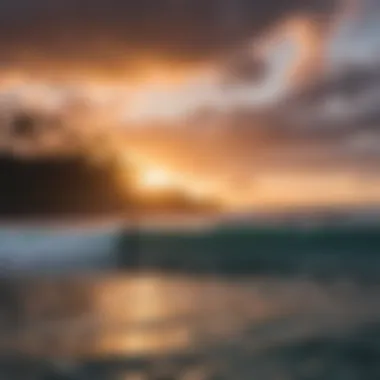

Different Types of Surfboards
There are several types of surfboards, each crafted to meet varying surfing styles and conditions. Shortboards, for instance, are designed for high performance on steep waves. They are typically more maneuverable and responsive, allowing experienced surfers to execute sharp turns and tricks. On the other hand, longboards offer stability and ease of paddling, making them an excellent choice for beginners. The wider, longer shape helps new surfers catch waves more easily.
Also, fish boards, with their distinct shape, are popular for their ability to glide smoothly over small, mushy waves. They are a good option if you find yourself surfing in less than ideal conditions. Therefore, selecting a board that aligns with both the local surf conditions and your skill level is vital for success.
Guidelines for Beginners vs. Experts
For beginners navigating the surf for the first time, the focus should be on stability and ease of use. Longboards or softer top boards work wonders, allowing novice surfers confidence to get up and ride. A reliable guideline is that a beginner should choose a board that’s longer and wider, as it presents a larger surface area, thus making balancing easier.
Experts, on the flip side, generally prefer shortboards or performance boards tailored for specific conditions, allowing for greater agility and speed on bigger waves. They know the advantages of a well-fitted surfboard, ensuring that they can push their limits while battling the roiling waters off the Big Island's coast. Ultimately, understanding the distinction between beginner and expert gear can significantly enhance one’s surfing journey.
Necessary Safety Equipment
Safety equipment serves as an essential lifeline for surfers, ensuring that adventurers can enjoy their time in the ocean while minimizing risks.
Leashes and Wax
Every surfer worth their salt knows the value of a good leash. A surfboard leash keeps your board tethered to you, preventing potentially dangerous situations where your board could travel away and harm someone while you’re trying to navigate the waves. When choosing leashes, consider the thickness and material; thicker leashes offer more durability if you encounter powerful surf.
And then there’s wax—an often-overlooked essential. Applying the right kind of wax provides grip onto your surfboard, enabling you to stand firmly even with splashing waves knocking about. Using the right temperature-specific wax that corresponds to the water temperature can enhance your surfing experience, promoting a more seamless ride.
Impact Vests and Helmets
If you think helmets are just for skateboarding, think again. Impact vests and helmets are gaining traction among surfers concerned about safety. These gear pieces are particularly valuable for those surfing heavier waves or in more challenging locations. An impact vest cushions your body against the board and water surface in a wipeout, potentially preventing injuries.
Helmets, while often underused, can offer necessary protection against collisions with your own or another surfer’s board. Comfortable and lightweight options encourage their use, allowing surfers to focus on the waves without the fear of unnecessary injury.
Understanding the importance of each piece of gear is paramount for a successful surfing experience on the Big Island. Having the right surfboard, along with safety equipment, can make your venture not only enjoyable but also safe, preserving the spirit of surfing for generations to come.
Surf Schools and Lessons
Learning how to ride the waves on Hawaii's Big Island is a rite of passage for many who venture here. Surf schools play a critical role in shaping surf culture, acting as gateways for newcomers to this exhilarating world. Beyond just providing lessons, these establishments teach the essential respect for the ocean and its conditions, which is fundamental for any surfer. Knowledge gained from trained instructors can help beginners avoid dangerous situations and also cultivate a more profound appreciation for the sport.
Attending a surf school can be especially advantageous for those completely new to surfing, as instructors are seasoned professionals who understand local conditions and idiosyncrasies. This means learners gain invaluable insights into the currents, tides, and breaks that characterize the Big Island's surf scene. In essence, surf schools offer a safe and guided path into this fascinating subculture, where passion meets safety, skill meets respect, and personal growth merges with a love for nature.
Popular Surf Schools on the Big Island
When it comes to surf schools on the Big Island, several stand out for their exceptional instruction and local knowledge.
- Kona Surf Company: This school hails from Kailua-Kona. With small class sizes and experienced instructors, they focus heavily on personalized guidance.
- Hilo Surf School: Situated on the eastern side, it's known for its friendly atmosphere and adaptable lesson plans tailored to individual needs.
- Puna Surf Company: Located in Pahoa, they emphasize fun alongside learning, making sure that new surfers have a good time while mastering the fundamentals of surfing.
Each of these schools brings its own flair to teaching and connects learners to the rich surf culture of the island, helping them carve paths from novices to competent surfers.
What to Expect from a Surf Lesson
Learning to surf is more than just jumping on a board; it's an immersive process that can significantly add to your experience on the Big Island. Here’s what you can expect when you sign up for a surf lesson.
Typical Lesson Structures
Surf lessons are generally structured to cater to the varying levels of skill and understanding. An introductory lesson often starts on the sand, where instructors explain the basics—like paddling techniques and how to pop up—before students get their feet wet.
- Key characteristic: Hands-on approaches with full support.
- Benefits: This allows for immediate practice under supervision.
During the lesson, students might split their time between land drills and actual surfing. A typical session could last around 2 hours, offering enough time to practice and improve without feeling rushed.
Unique feature: Most surf lessons incorporate a safety briefing, an essential aspect that instills confidence and awareness about ocean dynamics.
Skills Development Focus
A well-structured surf lesson emphasizes skill development over mere fun. This focus ensures that participants not only learn to ride the waves but understand how to maneuver effectively in varying surf conditions.
- Key characteristic: Developmental learning frameworks that prioritize growth.
- Benefits: Students build a foundational skill set that enhances their ability to surf independently and responsibly.
The lessons focus on techniques like paddling, timing your takeoff, or adjusting your stance on the board, instilling fundamental skills that are vital for progression in the sport.
Unique feature: Many instructors encourage understanding the waves—teaching students to read them, which is a critical skill that can set a surfer apart on the line-up.
"Surfing isn’t just about riding waves; it’s about understanding the ocean."
By joining a surf school on the Big Island, surfers can immerse themselves in learning, surrounded by like-minded individuals eager to catch their first wave, or refine their skills under expert guidance.
Cultural Respect and Local Etiquette
Surfing is more than just a sport in Hawaii; it’s woven into the very fabric of the islands’ culture. Understanding and respecting this heritage is not just an act of goodwill but an essential part of participating in the surfing community on the Big Island. By appreciating the traditions and customs, surfers can enhance their experience while contributing positively to the local environment. Engaging with Hawaiian surf culture opens up opportunities for communal connection, shared experiences, and a deeper appreciation of the ocean and its power.
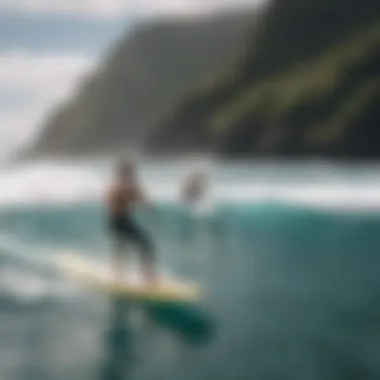

Understanding Hawaiian Surf Culture
Hawaiian surf culture is rich in history and diverse traditions, originating from the native Hawaiian way of life. Surfing was called "he‘e nalu," meaning "to glide on a wave." This practice was often reserved for chieftains, showcasing their prowess and connection to the ocean. Today, this deep-seated respect persists, with modern surfers encouraged to honor the ocean's sacredness.
The ocean is seen as a source of both life and spirituality for many locals. This connection is reflected in various practices, such as offering lei or prayers before heading out into the water. Surfing in Hawaii is not just about riding the waves; it is about embracing the island’s spirit and acknowledging one's place within it. For tourists, recognizing this cultural significance is vital. Being respectful can lead to memorable interactions and a more enriching experience overall.
Surf Etiquette for Visitors
Visiting surfers should grasp the unwritten rules that govern surf behaviour. Familiarity with surf etiquette isn’t just polite; it fosters safer and more enjoyable surf sessions for everyone. Here’s what to keep in mind:
Right of Way Rules
Understanding the right of way in surfing is crucial. The surfer closest to the breaking wave is generally considered to have priority. This rule fosters safety and smooth wave riding, minimizing the chance of collisions. It might seem simple, but ignoring this principle can lead to friction among surfers, especially in crowded spots.
- Key Characteristic: The basic right of way keeps order in the lineup. It reduces misunderstandings and potential conflicts.
- Unique Feature: Each break might have its own informal agreements about who gets to go first, based on local surfer dynamics.
- Advantages/Disadvantages: Adhering to these rules promotes camaraderie but can sometimes feel intimidating for newcomers. Still, it's better to ask a local than to risk causing a scene.
Interacting with Locals
When you’re out in the water, the manner in which you interact with locals can make a world of difference. Taking the time to learn a few Hawaiian phrases, like greetings or thank-yous, not only shows respect but may earn you some local goodwill, possibly leading to surf tips or recommendations.
- Key Characteristic: Genuine interaction with local surfers often leads to invaluable advice about the breaks and surf conditions.
- Unique Feature: A simple smile and a respectful approach can transform the experience. Many locals appreciate enthusiasm but expect understanding of their customs and ocean respect.
- Advantages/Disadvantages: While most locals are friendly, missteps can lead to backlash, so being observant and courteous will open doors rather than close them.
It is said that surfing in Hawaii is about the 'aloha spirit'—a sense of respect, love, and unity. Embracing this spirit can make your surfing experience not only enjoyable but also memorable in a meaningful way.
In summary, approaching Hawaiian surf culture with sensitivity and respect is essential. Knowing the local etiquette fosters better experiences in the water and helps in preserving the islands’ cultural heritage. For surfers seeking an authentic connection, demonstrating respect for these values can create lasting friendships and unforgettable memories.
Environmental Considerations
Surfing on the Big Island offers both thrills and a unique connection to nature, but it carries responsibilities that surfers must not overlook. The topic of Environmental Considerations is not merely an add-on; it forms the backbone of sustainable surfing practices. Engaging with these considerations ensures that surfers enjoy the waves while minimizing their impact on delicate ecosystems. This is particularly pertinent as the Big Island is a treasure trove of biodiversity, making it essential to respect and protect what lies beneath the water.
Impact of Surfing on Local Ecosystems
Coral Reefs and Marine Life
Coral reefs stand as some of the most vibrant ecosystems on the planet, and the Big Island's reefs are no exception. These underwater gardens provide a home for countless marine species and play a crucial role in maintaining the health of the ocean. Surfing can unfortunately disrupt these fragile systems, particularly when surfers are not mindful of their surroundings. When paddling out, surfers risk damaging coral structures, which can take years to recover. Understanding the significance of protecting these reefs is vital for anyone looking to ride the waves.
- Key Features of Coral Reefs: They serve as breeding grounds for numerous fish species, making them vital for local fisheries and the broader marine food web.
- Advantages of Healthy Reefs: Healthy coral reefs can absorb wave energy, protecting shorelines from erosion and contributing to the overall health of coastal environments.
Pollution and Conservation Efforts
Pollution is a significant concern that surfers need to actively combat. Litter, waste from boats, and chemicals from land runoff can severely affect water quality and marine life. The irony is that while surfers seek pristine waters, they often contribute to their degradation without even realizing it. Key conservation efforts are underway to address this issue. Local organizations work tirelessly to clean beaches and raise awareness about pollution.
- Important Efforts: Regular beach clean-ups organized by community groups are a great way for surfers to contribute directly to the health of their local environment.
- Unique Actions: Setting up recycling stations on popular surf beaches helps reduce litter and educates visitors about waste management.
Sustainable Surfing Practices
Eco-Friendly Gear Options
As the surfing community becomes increasingly aware of the environmental impact of their activity, eco-friendly gear options are gaining traction. From surfboards made of sustainable materials to biodegradable wax, these choices not only lessen damage to the environment but can also enhance your surfing experience.
- Key Characteristics: Many surf brands are now producing gear that minimizes carbon footprints and employs ethical manufacturing processes.
- Unique Features: For example, boards crafted from recycled materials provide surfers with both performance and conscience.
Supporting Local Conservation Programs
Surfing enthusiasts are uniquely positioned to influence conservation efforts, especially when they support local programs aiming to protect marine ecosystems. Engaging with community initiatives fosters a sense of responsibility and connection to the environment.
- Key Characteristic: Many conservation programs offer volunteer opportunities specifically aimed at surfers to directly participate in preservation activities.
- Unique Benefits: By supporting these local initiatives, surfers not only contribute to conservation but also gain insights into the ecosystem they enjoy.
Ultimately, understanding and integrating environmental considerations into surfing practices on the Big Island contributes to a more sustainable future for both the sport and the oceans. By prioritizing eco-friendly choices and engaging with conservation efforts, surfers can help to safeguard Hawaii's natural treasures for generations to come.
Culmination
Surfing on the Big Island of Hawaii is not just a pastime; it's a way of life deeply woven into the fabric of the island's culture and history. This article systematically highlights the essential elements of surfing in this glorious location. A recap of the key points reminds us of the area's unique surfing spots, the significance of understanding local etiquette, and the need for sustainable practices.
Recap of Surfing on the Big Island
The Big Island offers an unparalleled surfing experience with its varied landscapes, from the vibrant Kona Coast to the more untamed Hilo area. Each region brings its own set of waves, inviting surfers with different skill levels to ride at their own pace. Having explored these different aspects, it's clear that each surfing location holds its own charm. Moreover, understanding the environmental impacts of surfing allows enthusiasts to reconnect with nature rather than exploit it.
"Surfing is not only about riding the waves; it's about respecting the ocean, the land, and the culture that surrounds it."
This connection is vital, fostering a deeper appreciation for the majestic beauty of the Big Island and the marine ecosystems that thrive there.
Encouragement for Responsible Surfing
As we wrap up this exploration, it’s crucial to emphasize responsible surfing practices. Surfers must remember that they are not merely visitors but part of a community that depends on the local wildlife and ecosystems. Respecting local surf etiquette ensures that you not only enjoy your experience but also contribute positively to the community.
Here are a few reminders for every surfer:
- Know the rules: Each surfing spot has its own set of unwritten guidelines. Understanding local customs goes a long way in fostering a good relationship with the surfing community.
- Be mindful of nature: Always take precautions to prevent pollution, such as avoiding plastic use and properly disposing of waste.
- Support local: Engage with local surf schools and shops which contribute to the economy and promote sustainability.
With responsible surfing, everyone can enjoy the waves while nurturing the precious environment of the Big Island. Let's paddle out, catch some incredible waves, and do so with the respect and reverence that surfing deserves.













